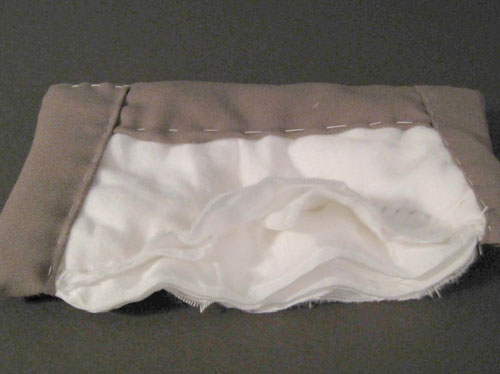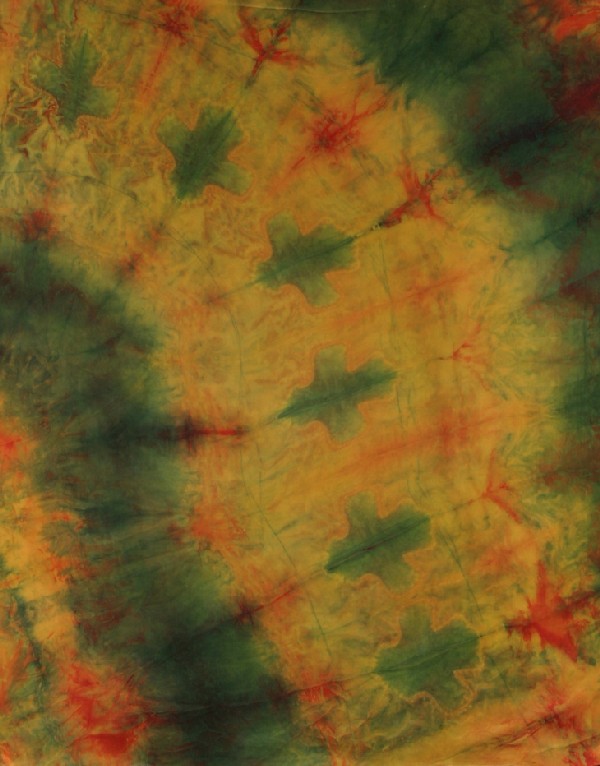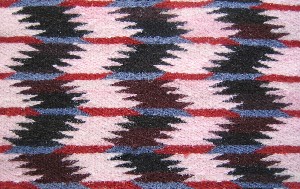Falling Leaf Shibori
by Abi Chodosh
When I teach a Shibori class, I begin with a bowl of clean water, and say to
|
the students gathered around the bowl, "If you submerge your fist into the water, how tightly do you have to clench so that your palm stays dry?" One by one, they try. As each palm emerges, we examine it closely for wet vs. dry patches of skin. Abundant giggles and sighs fill the room as each student experiences the tension needed to resist the flow of water. They will use this information later when they tie, stitch, or clamp fabric they will immerse in dye. I often think about the properties of flow, and its qualities such as velocity and direction. Movement can be charted on a flow-resistance continuum. When I work with natural dyes on bound cloth, I track color changes as dye particles migrate through solution and attach to molecules of silk. In "Falling Leaf Shibori," the image of gently floating leaves implies matter in motion. The visual language of the forest articulates a complex eco-system based on interactions between multiple life forms and atmospheric conditions. It is this organic visual language, which guides my choice of design elements: gently curving lines; richly variegated areas of dappled color; the leaf as a design motif; and pigment directly extracted from plants, minerals, and insects. The "Falling Leaf Shibori" design process begins with a loose sketch defining the placement of cascading leaves. Spacing between leaves can be regular or varied as they descend along a straight or curvilinear path. Leaf morphology, size and shape all reveal the species of the tree. With the goal of suggesting the luminosity of a forest when sparkles of sunlight break through the canopy, I choose an imaginative color scheme for the background and leaf areas. This color choice defines the order for the series of dye baths that will be applied to silk. The silk is mordanted with aluminum sulfate before it is dyed with cochineal, madder, fustic, Osage orange, weld, indigo, walnut, lac, logwood grey, or cutch. The dried weld, Osage orange, or fustic is used in whole flower or wood chip form to achieve a clear yellow color, while the extract forms of cochineal, madder, lac, logwood grey, and cutch are used to minimize preparation time. Locally grown walnut husks are used as a tannin dye. When dyeing with indigo, I use soda ash to adjust the pH and thiox as a reducing agent. Each dye exhibits a particular personality based on factors such as speed of uptake onto the cloth, (which ranges from two hours for cutch, to just seconds for indigo) as well as level of color intensity produced on silk. In "Falling Leaf Shibori" a stitching line, in the shape of the outline of a leaf, is used to control the flow of dye. In this stitch-bound resist |
 Radiant Shadow. 60" x 10"
Radiant Shadow. 60" x 10"Silk, Alum, Fustic, Indigo, Cutch, Logwood Grey, Walnut, Discharge Paste Photograph Copyright by Abi Chodosh |
In order to selectively apply dye to specific areas, protective cloth flaps are sewn across the edge of the exposed silk. This added fabric blocks the flow of dye, prohibiting it from reaching either the background or leaf sections of the silk. Placement of the protective flaps is dictated by the choice of colors and color mixtures. Before entering the silk into each dye bath, the flaps can be added or removed.

It was during my first experiment with Katano Shibori that I developed "Falling Leaf Shibori." Katano Shibori uses stitching on folded and covered cloth. As a mistake in regard to proper use of the protective cloth, I used a flannel covering cloth that was larger than the folded silk thereby blocking the flow of indigo from coming in contact with the interior silk. Realizing that flannel fabric could resist dye; I conceived the idea of using fabric flaps to achieve multi-colored Katano dyeing. A photo of Mr. Katano Motohike squeezing a bundle of cloth, to force indigo to penetrate many layers of cloth can be viewed at www.shibori.org.
"Falling Leaf Shibori" adapts the Katano concept in a loose painterly style by using the low water immersion dyeing technique. Here the dye pots are only filled with an inch or two of concentrated natural dye. Also, the folded cloth is placed in the dye pot so that only one edge is submerged in the dye. This allows uneven dyeing, as the dye wicks up and into unsubmerged areas. At the same time, the fabric is allowed to dry wrinkled, which allows pigment to pool and take up unevenly. This handling of materials helps achieve organic shapes, dappled colors, and high intensity splotches. The dye concentration, the length of time the silk is in the dye pot, and the specific chemistry of the dye molecules also affect how far dye diffuses through the layers of silk.
After the base colors are applied though a series of dye applications, I peek into the folded silk and try to imagine the finished piece. To achieve further visual interest I apply a combination of surface design methods such as additional applications of dye, rust transfer, dye discharge, or earth pigments. To produce rust transfer, a piece of corroded metal is placed between dampened layers of silk, and, as the fabric dries, iron travels through the fabric creating dark irregular stains. To lift color and create a subtle cloud-like effect, I use applications of discharge paste, although this method works only on a few natural dyes. Opaque earth pigments, combined with soymilk as a binder, can be painted onto the translucent natural dyes, and a light wash of mica creates a shimmering effect. The final result is visible only when the fabric is untied, rinsed, and dried.

I frame the ironed silk by placing it between a pair of wooden slats made of wenge, walnut, paduak, or ebony wood. To display this microcosm of the forest, I suspend the silk from the ceiling so that it sways with ambient wind currents. As an artist, I work with the cloth and dye in wet form while the viewer experiences the effect of multiple layers of color wash on dry silk. For me, it is innovation and experimentation that keep Shibori and the ancient art of natural dyes living arts.
|
Intricate Webbings of Hooligans. 60" x 10" Silk, Alum, Cutch, Indigo, Madder, Mica, Soy Milk, Rust. |
Yielding Flame. 60" x 10" Silk, Alum, Cochineal, Indigo, Cutch, Logwood Grey, Walnut, Discharge Paste |
 |
 |
| Photograph Copyright by Abi Chodosh | Photograph Copyright by Abi Chodosh |
 Turkey Red Journal
Turkey Red Journal
